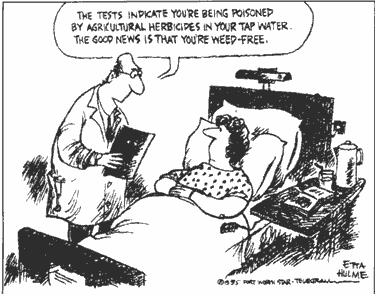December 2009
Go here if you'd like to read this issue on our website.
An email extension of the Pure Water Gazette.
In this issue of the Occasional you'll hear about bottled water named after the demilitairzed zone and learn which city has the 100th best drinking water. Learn what drink Jackson Browne bans at his concerts and hear about the EPA's new program for saving water. Hear about the US military's anti-regulatory propaganda and learn how to remove vinyl chloride from drinking water. The magnificent water studies published by the New York Times, the fantastic number of bacteria in our bodies, the water usage of the Tiger Woods golf course in Dubai, the number of deaths each year from unsanitary toileting, and, as always, much, much more.
The Pure Water Gazette wishes you a Happy and Prosperous 2010.
While you were Christmas shopping, a lot of important things happened. Follow the links if you want to read more.
Water News From Around the World
The Environmental Working Group rated Arlington, TX water best in the nation and Pensacola, FL water 100th.

The New York Times' Great Water Article
by Hardly Waite
Back
in 1992 when the paper Pure Water Gazette printed an entire issue
called "The Gazette's Great Water Article," magazine stories about the
condition of US waters were common. Unfortunately, though magazines
and newspapers keep grinding out articles that point out the same old
shortcomings of the way
the US cares for its most precious
resource, nothing of significance has been done to change things since
the Clean Water Act of the 1970s.
I regret to say it isn't likely that things will change.
There
is simply no political will to address the serious problems facing the
nation's water supplies, and there are rich and powerful vested
interests who beat down every attempt at reform.
Here are a few examples of the problems.
There
are now, by the EPA's estimate, some 60,000 chemicals being used in the United States. The EPA, the regulatory agency
which was created under the Clean Water Act to look after our water supplies, has regulatory standards
for only 91 of these. The remaining 59,900 or so are not being monitored by your water supplier.
Attempts to broaden regulation are met immediately with crushing opposition from wealthy opponents in industry or even our own government. States oppose regulations that would affect businesses, although the health of their citizens is at stake.
Every attempt to regulate use of the powerful
water contaminant perchlorate, a rocket fuel ingredient, has been fought by
the mighty propaganda machine of the US military. Military
propagandists publicly question the patriotism of proponents of
perchlorate regulation. If you love your country, you'll drink your rocket fuel and keep your mouth shut.
The regulatory standards for the tiny
number of contaminants the EPA has acted upon are pitifully
inadequate, and enforcement is lax. And the standards themselves are of very questionable accuracy.
The truth is that no one really
knows how much vinyl chloride or benzene one can safely ingest over a
period of years. Contrary to the mythology promoted by regulating agencies and water suppliers, the EPA's magic numbers
aren't based on some concrete and absolute scientific standard that
deserves our confidence. EPA standards are politically negotiated
numbers--backroom compromises that set the standard somewhere between an assumed safe level and what
is convenient for the polluting industry or the water supplier. Even
the "science" used by regulators to determine safe levels is laughable; it is still based, now, in the 21st century, largely on "animal studies," a
branch of science that would have died in the Middle Ages if it were
not so profitable and useful to manipulators.
Similarly, few Americans seem aware of the deplorable state of the
aging infrastructure that handles our water and sanitation systems.
The original Clean Water Act provided at least limited funds for the
rebuilding of the nation's water and sanitation systems. Since that
time, although Congress has found ample funds for endless wars, bank
bailouts, and tax relief for the super rich, there is never any money
for such unglamorous items as the expansion and repair of sewage
systems that were designed for half the population that we now have.
In most urban areas today, even a 1/2" rain shower overwhelms the drainage
system and pours thousands of gallons of untreated sewage and chemical
runoff into drinking water reservoirs.
These and many other aspects of the highly inadequate management of our
water resources are discussed at length in an exceptional multi-article
study that has been appearing during the past few months in the New York Times. These well-documented
pieces include information that cause one to think twice before
trusting the water that comes straight from the tap. From the Times'
studies one learns, for example, that since 2004 “the water provided to
more than 49
million people has contained illegal concentrations of chemicals like
arsenic or radioactive substances like uranium, as well as dangerous
bacteria often found in sewage.” The Times confirms the finding of
previous Associated Press studies that one in six Americans
is
ingesting pharmaceuticals in their drinking water.
Most discouraging
of all is the finding that there have been more than half a million
violations of the Clean Water Act committed by water suppliers since
2004 and only 6 percent of the water systems that broke the law were
ever fined or in any way punished by state and federal officials.
A substantial portion of the Times reports can be found here:
•http://www.nytimes.com/2009/12/17/us/17water.html?_r=2&th&emc=th
• http://www.nytimes.com/2009/12/08/business/energy-environment/08water.html?_r=1&sudsredirect=true
• http://projects.nytimes.com/toxic-waters
I hope you'll read them. There's a wealth of information, and especially several video reports worth watching. Watch the videos. You'll like them.

Featured Water Issue : Vinyl Chloride
This issue's featured water contaminant, vinyl chloride, is not found in nature. It's a man-made cancer causer that gets into water supplies mainly as a result of manufacturing emissions and spills. It serves as a raw material to produce polyvinyl chloride (PVC) polymers (plastics). PVC is used to manufacture many industrial and consumer products: water and sewer pipe, wire insulation, floor and wall coverings, toys, medical devices, food packaging, etc. Vinyl chloride is a known carcinogen. It is a danger especially to workers in manufacturing plants where it is used. As a water contaminant, the greatest danger is from contaminated wells.
Removal of vinyl chloride is accomplished best by filtration with granular activated carbon and by reverse osmosis units. Some distillers remove vinyl chloride.
Go here for more information.

Numerical water facts from B. Bee Sharper, the Pure Water Gazette's certified number wizard.
Percentage of bathroom showerheads that harbor unhealthy levels of bacteria, as reported in a University of Colorado study: 30.
Average daily water use by each American: 500 liters.
Average daily water use by each citizen of England: 200 liters.
Daily water usage increase in the U. S. since 1950: 127 percent.
Daily operating cost of vehicles used in deep sea exploration: $50,000.
Percentage of all sickness and disease worldwide that are caused by lack of sanitation and unsafe water: 80%.
Go here for More B.B. Sharper.

